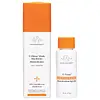What's inside
What's inside
 Key Ingredients
Key Ingredients

 Benefits
Benefits

 Concerns
Concerns

No concerns
 Ingredients Side-by-side
Ingredients Side-by-side

Water
Skin ConditioningDimethyl Isosorbide
SolventAscorbic Acid
AntioxidantLaureth-23
CleansingGlycerin
HumectantTocopherol
AntioxidantLactobacillus/Pumpkin Ferment Extract
Skin ConditioningSclerocarya Birrea Seed Oil
HumectantDipotassium Glycyrrhizate
HumectantGlycyrrhiza Glabra Root Extract
BleachingVitis Vinifera Juice Extract
AntioxidantFerulic Acid
AntimicrobialPhyllanthus Emblica Fruit Extract
HumectantCamellia Sinensis Leaf Extract
AntimicrobialLactobacillus/Punica Granatum Fruit Ferment Extract
Skin ConditioningPropanediol
SolventGluconolactone
Skin ConditioningSodium Hyaluronate Crosspolymer
HumectantSodium Hyaluronate
HumectantOryza Sativa Bran Extract
Skin ConditioningGlutamylamidoethyl Imidazole
Tetrahydrobisdemethoxydiferuloylmethane
AntioxidantTetrahydrodemethoxydiferuloylmethane
AntioxidantTetrahydrodiferuloylmethane
AntioxidantPentylene Glycol
Skin ConditioningCaprylhydroxamic Acid
Leuconostoc/Radish Root Ferment Filtrate
AntimicrobialSorbic Acid
PreservativePhenoxyethanol
PreservativeSodium Benzoate
MaskingCaprylyl Glycol
EmollientChondrus Crispus Extract
Skin ConditioningEthylhexylglycerin
Skin ConditioningWater, Dimethyl Isosorbide, Ascorbic Acid, Laureth-23, Glycerin, Tocopherol, Lactobacillus/Pumpkin Ferment Extract, Sclerocarya Birrea Seed Oil, Dipotassium Glycyrrhizate, Glycyrrhiza Glabra Root Extract, Vitis Vinifera Juice Extract, Ferulic Acid, Phyllanthus Emblica Fruit Extract, Camellia Sinensis Leaf Extract, Lactobacillus/Punica Granatum Fruit Ferment Extract, Propanediol, Gluconolactone, Sodium Hyaluronate Crosspolymer, Sodium Hyaluronate, Oryza Sativa Bran Extract, Glutamylamidoethyl Imidazole, Tetrahydrobisdemethoxydiferuloylmethane, Tetrahydrodemethoxydiferuloylmethane, Tetrahydrodiferuloylmethane, Pentylene Glycol, Caprylhydroxamic Acid, Leuconostoc/Radish Root Ferment Filtrate, Sorbic Acid, Phenoxyethanol, Sodium Benzoate, Caprylyl Glycol, Chondrus Crispus Extract, Ethylhexylglycerin
Water
Skin ConditioningGlycerin
HumectantDicaprylyl Carbonate
EmollientCaprylic/Capric Triglyceride
MaskingCetearyl Alcohol
EmollientPersea Gratissima Oil
Skin ConditioningCetearyl Olivate
Niacinamide
SmoothingCetyl Alcohol
EmollientPhenoxyethanol
PreservativeSorbitan Olivate
EmulsifyingHydrogenated Ethylhexyl Olivate
EmollientSodium Ascorbyl Phosphate
AntioxidantHydroxyethyl Acrylate/Sodium Acryloyldimethyl Taurate Copolymer
Emulsion StabilisingSqualane
EmollientXanthan Gum
EmulsifyingHydrogenated Olive Oil Unsaponifiables
EmollientCarbomer
Emulsion StabilisingChlorphenesin
AntimicrobialPolysorbate 60
EmulsifyingPentaerythrityl Tetra-Di-T-Butyl Hydroxyhydrocinnamate
AntioxidantSodium Hyaluronate
HumectantSorbitan Isostearate
EmulsifyingAlcohol
AntimicrobialTris(Tetramethylhydroxypiperidinol)Citrate
StabilisingTocopherol
AntioxidantGlycine Soja Oil
EmollientCI 19140
Cosmetic ColorantCI 16035
Cosmetic ColorantWater, Glycerin, Dicaprylyl Carbonate, Caprylic/Capric Triglyceride, Cetearyl Alcohol, Persea Gratissima Oil, Cetearyl Olivate, Niacinamide, Cetyl Alcohol, Phenoxyethanol, Sorbitan Olivate, Hydrogenated Ethylhexyl Olivate, Sodium Ascorbyl Phosphate, Hydroxyethyl Acrylate/Sodium Acryloyldimethyl Taurate Copolymer, Squalane, Xanthan Gum, Hydrogenated Olive Oil Unsaponifiables, Carbomer, Chlorphenesin, Polysorbate 60, Pentaerythrityl Tetra-Di-T-Butyl Hydroxyhydrocinnamate, Sodium Hyaluronate, Sorbitan Isostearate, Alcohol, Tris(Tetramethylhydroxypiperidinol)Citrate, Tocopherol, Glycine Soja Oil, CI 19140, CI 16035
 Reviews
Reviews

Ingredients Explained
These ingredients are found in both products.
Ingredients higher up in an ingredient list are typically present in a larger amount.
Glycerin is already naturally found in your skin. It helps moisturize and protect your skin.
A study from 2016 found glycerin to be more effective as a humectant than AHAs and hyaluronic acid.
As a humectant, it helps the skin stay hydrated by pulling moisture to your skin. The low molecular weight of glycerin allows it to pull moisture into the deeper layers of your skin.
Hydrated skin improves your skin barrier; Your skin barrier helps protect against irritants and bacteria.
Glycerin has also been found to have antimicrobial and antiviral properties. Due to these properties, glycerin is often used in wound and burn treatments.
In cosmetics, glycerin is usually derived from plants such as soybean or palm. However, it can also be sourced from animals, such as tallow or animal fat.
This ingredient is organic, colorless, odorless, and non-toxic.
Glycerin is the name for this ingredient in American English. British English uses Glycerol/Glycerine.
Learn more about GlycerinPhenoxyethanol is a preservative that has germicide, antimicrobial, and aromatic properties. Studies show that phenoxyethanol can prevent microbial growth. By itself, it has a scent that is similar to that of a rose.
It's often used in formulations along with Caprylyl Glycol to preserve the shelf life of products.
Sodium Hyaluronate is hyaluronic acid's salt form. It is commonly derived from the sodium salt of hyaluronic acid.
Like hyaluronic acid, it is great at holding water and acts as a humectant. This makes it a great skin hydrating ingredient.
Sodium Hyaluronate is naturally occurring in our bodies and is mostly found in eye fluid and joints.
These are some other common types of Hyaluronic Acid:
Learn more about Sodium HyaluronateTocopherol (also known as Vitamin E) is a common antioxidant used to help protect the skin from free-radicals and strengthen the skin barrier. It's also fat soluble - this means our skin is great at absorbing it.
Vitamin E also helps keep your natural skin lipids healthy. Your lipid skin barrier naturally consists of lipids, ceramides, and fatty acids. Vitamin E offers extra protection for your skin’s lipid barrier, keeping your skin healthy and nourished.
Another benefit is a bit of UV protection. Vitamin E helps reduce the damage caused by UVB rays. (It should not replace your sunscreen). Combining it with Vitamin C can decrease sunburned cells and hyperpigmentation after UV exposure.
You might have noticed Vitamin E + C often paired together. This is because it is great at stabilizing Vitamin C. Using the two together helps increase the effectiveness of both ingredients.
There are often claims that Vitamin E can reduce/prevent scarring, but these claims haven't been confirmed by scientific research.
Learn more about TocopherolWater. It's the most common cosmetic ingredient of all. You'll usually see it at the top of ingredient lists, meaning that it makes up the largest part of the product.
So why is it so popular? Water most often acts as a solvent - this means that it helps dissolve other ingredients into the formulation.
You'll also recognize water as that liquid we all need to stay alive. If you see this, drink a glass of water. Stay hydrated!
Learn more about Water